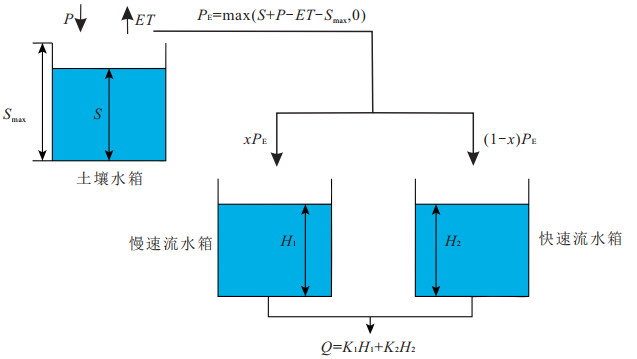Modelling the hydrological process of the karst spring using a revised Vensim model
-
摘要:
经典的Vensim模型采用2个平行线性水箱来模拟岩溶水文系统中的慢速流和快速流, 很难模拟岩溶水文系统内的非线性水文过程。提出一种改进的R-Vensim模型, 将Vensim中的一个水箱改为非线性水箱, 同时进一步考虑不同水文条件下降雨分配系数的变化, 用于模拟岩溶含水层中存在的非线性水文过程。2个模型被用于模拟丫吉试验场的S31岩溶泉, 模拟结果表明R-Vensim能更好地模拟不同降雨条件下岩溶泉水文动态过程, 而Vensim总是低估暴雨下的流量峰值和高估低强度降雨下的流量峰值。研究区岩溶水文系统中慢速流呈现强烈的非线性, 而快速流更接近于线性过程, 2个模拟时段内78.5%和68.4%的泉流量来源于非线性水箱。研究结果表明模型中考虑非线性水文过程对于岩溶泉流量尤其低流量过程的精准模拟十分重要。
Abstract:The conventional Vensim model uses two parallel reservoirs to simulate the slow and fast flows in karst systems, which can hardly simulate the existing nonlinear hydrological process. This paper proposed a revised Vensim model (R-Vensim) to further enhance its ability to simulate the nonlinear hydrological process in karst systems. This revised version changed one linear reservoir in the Vensim model into a nonlinear reservoir and considered the variation in the distribution coefficient under different hydrological conditions. The two models were applied to simulate the discharge of karst spring S31 located at the Yaji experimental site. The simulation results indicated that the R-Vensim model can reasonably reproduce the discharge dynamics under different precipitation conditions, whereas the Vensim model underestimated the fast flow peaks and overestimated the slow flow peaks. In the study catchment, the fast flow was almost linear, whereas the slow flow was highly nonlinear. In the calibration period, 78.5% of spring discharge came from the nonlinear reservoir. The results showed that, considering the nonlinear hydrological process was a key issue to accurately simulate the karst spring, particularly for the slow flow condition.
-
Key words:
- karst /
- conceptual model /
- nonlinear hydrological process /
- Vensim model /
- Yaji experimental site
-
表 1 Vensim和R-Vensim最优参数率定值
Table 1. Optimal parameter values in Vensim and R-Vensim model after calibration
表 2 2个模型在校正期和验证期目标函数值
Table 2. Objective values of the two models in the calibration and validation periods
模型 Nashsqrt Nash Nashln 校正期 Venism 0.83 0.85 0.61 R-Venism 0.90 0.92 0.70 验证期 Venism 0.75 0.77 0.11 R-Venism 0.84 0.88 0.50 -
[1] 单海平, 邓军. 我国西南地区岩溶水资源的基本特征及其和谐利用对策[J]. 中国岩溶, 2006, 25(4): 324-329. https://www.cnki.com.cn/Article/CJFDTOTAL-ZGYR200604011.htmShan H P, Deng J. Basic features and counter-measures for use of karst water in Southwest China[J]. Carsologica Sinica, 2006, 25(4): 324-329(in Chinese with English abstract). https://www.cnki.com.cn/Article/CJFDTOTAL-ZGYR200604011.htm [2] 常勇, 刘玲. 岩溶地区水文模型综述[J]. 工程勘察, 2015, 43(3): 37-44. https://www.cnki.com.cn/Article/CJFDTOTAL-GCKC201503007.htmChang Y, Liu L. Review of karst hydrological models[J]. Geotechnical Investigation & Surveying, 2015, 43(3): 37-44(in Chinese with English abstract). https://www.cnki.com.cn/Article/CJFDTOTAL-GCKC201503007.htm [3] 吴乔枫, 刘曙光, 蔡奕, 等. 流域非闭合特性对岩溶地区水文过程模拟的影响[J]. 水利学报, 2017, 48(4): 457-466. https://www.cnki.com.cn/Article/CJFDTOTAL-SLXB201704009.htmWu Q F, Liu S G, Cai Y, et al. Effect of unclosed characteristics of the basin on hydrological modeling in karst regions[J]. Journal of Hydraulic Engineering, 2017, 48(4): 457-466(in Chinese with English abstract). https://www.cnki.com.cn/Article/CJFDTOTAL-SLXB201704009.htm [4] Chang Y, Wu J, Jiang G, et al. Identification of the dominant hydrological process and appropriate model structure of a karst catchment through stepwise simplification of a complex conceptual model[J]. Journal of Hydrology, 2017, 548: 75-87. doi: 10.1016/j.jhydrol.2017.02.050 [5] Duran L, Massei N, Lecoq N, et al. Analyzing multi-scale hydrodynamic processes in karst with a coupled conceptual modeling and signal decomposition approach[J]. Journal of Hydrology, 2020, 583: 124625. doi: 10.1016/j.jhydrol.2020.124625 [6] Fleury P, Plagnes V, Bakalowicz M. Modelling of the functioning of karst aquifers with a reservoir model: Application to Fontaine de Vaucluse(South of France)[J]. Journal of Hydrology, 2007, 345(1): 38-49. https://www.sciencedirect.com/science/article/pii/S0022169407004295 [7] Goldscheider N, Drew D. Methods in karst hydrogeology[C]//International Contributions to Hydrogeology, 26. London: Crc Press, 2007. [8] Fleury P. Sources sous-marines et aquiferes karstiques cǒtiers mediterraneens. fonctionnement et caracterisation[D]. Paris: Université Pierre Et Marie Curie-Paris Vi, 2005. [9] Charlier J B, Bertrand C, Mudry J. Conceptual hydrogeological model of flow and transport of dissolved organic carbon in a small Jura karst system[J]. Journal of Hydrology, 2012, 460/461: 52-64. doi: 10.1016/j.jhydrol.2012.06.043 [10] Hartmann A, Lange J, Aguado A V, et al. A multi-model approach for improved simulations of future water availability at a large eastern Mediterranean karst spring[J]. Journal of Hydrology, 2012, 468/469: 130-138. doi: 10.1016/j.jhydrol.2012.08.024 [11] Zhang Z C, Chen X, Cheng Q B, et al. Storage dynamics, hydrological connectivity and flux ages in a karst catchment: Conceptual modelling using stable isotopes[J]. Hydrology and Earth System Sciences, 2019, 23(1): 51-71. doi: 10.5194/hess-23-51-2019 [12] Tritz S, Guinot V, Jourde H. Modelling the behaviour of a karst system catchment using non-linear hysteretic conceptual model[J]. Journal of Hydrology, 2011, 397(3): 250-262. https://www.sciencedirect.com/science/article/pii/S0022169410007432 [13] Alparslan A. MODALP: A deterministic rainfall-runoff model for large karstic areas[J]. International Association of Scientific Hydrology Bulletin, 1988, 33(4): 401-414. [14] Bonacci O. Ground water behaviour in karst: Example of the Ombla Spring(Croatia)[J]. Journal of Hydrology, 1995, 165(1): 113-134. https://www.sciencedirect.com/science/article/pii/002216949402577X [15] Rozos E, Koutsoyiannis D. A multicell karstic aquifer model with alternative flow equations[J]. Journal of Hydrology, 2006, 325(1): 340-355. https://www.sciencedirect.com/science/article/pii/S0022169405005512 [16] 刘再华, Chris G, 袁道先, 等. 水-岩-气相互作用引起的水化学动态变化研究: 以桂林岩溶试验场为例[J]. 水文地质工程地质, 2003, 30(4): 13-18. https://www.cnki.com.cn/Article/CJFDTOTAL-SWDG200304003.htmLiu Z H, Chris G, Yuan D X, et al. Study on the hydrochemical variations caused by the water-rock-gas interaction: An example from the Guilin Karst Experimental Site[J]. Hydrogeology & Engineering Geology, 2003, 30(4): 13-18(Chinese with English abstract). https://www.cnki.com.cn/Article/CJFDTOTAL-SWDG200304003.htm [17] Halihan T, Wicks C M, Engeln J F. Physical response of a karst drainage basin to flood pulses: Example of the Devil's Icebox cave system(Missouri, USA)[J]. Journal of Hydrology, 1998, 204(1): 24-36. https://www.sciencedirect.com/science/article/pii/S0022169497001042 [18] Chang Y, Wu J C, Jiang G H. Modeling the hydrological behavior of a karst spring using a nonlinear reservoir-pipe model[J]. Hydrogeology Journal, 2015, 23(5): 1-14. doi: 10.1007/s10040-015-1241-6 [19] Eagleman J R. Pan evaporation, potential and actual evapotranspiration[J]. Journal of Applied Meteorology, 1967, 6(3): 482-488. [20] Duan Q Y, Sorooshian S, Gupta V. Effective and efficient global optimization for conceptual rainfall-runoff models[J]. Water Resources Research, 1992, 28(4): 1015-1031. doi: 10.1029/91WR02985 -





 下载:
下载:








